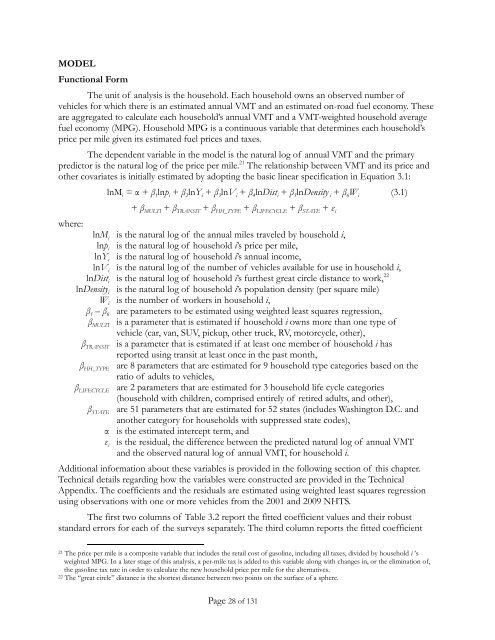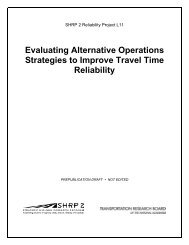Mileage-Based User Fee Winners and Losers - RAND Corporation
Mileage-Based User Fee Winners and Losers - RAND Corporation
Mileage-Based User Fee Winners and Losers - RAND Corporation
Create successful ePaper yourself
Turn your PDF publications into a flip-book with our unique Google optimized e-Paper software.
MODEL<br />
Functional Form<br />
The unit of analysis is the household. Each household owns an observed number of<br />
vehicles for which there is an estimated annual VMT <strong>and</strong> an estimated on-road fuel economy. These<br />
are aggregated to calculate each household’s annual VMT <strong>and</strong> a VMT-weighted household average<br />
fuel economy (MPG). Household MPG is a continuous variable that determines each household’s<br />
price per mile given its estimated fuel prices <strong>and</strong> taxes.<br />
The dependent variable in the model is the natural log of annual VMT <strong>and</strong> the primary<br />
predictor is the natural log of the price per mile. 21 The relationship between VMT <strong>and</strong> its price <strong>and</strong><br />
other covariates is initially estimated by adopting the basic linear specification in Equation 3.1:<br />
lnM i = α + β 1 lnp i + β 2 lnY i + β 3 lnV i + β 4 lnDist i + β 5 lnDensity i + β 6 W i (3.1)<br />
+ β MULTI + β TRANSIT + β HH_TYPE + β LIFECYCLE + β STATE + ε i<br />
where:<br />
lnM i is the natural log of the annual miles traveled by household i,<br />
lnp i is the natural log of household i’s price per mile,<br />
lnY i is the natural log of household i’s annual income,<br />
lnV i is the natural log of the number of vehicles available for use in household i,<br />
lnDist i is the natural log of household i’s furthest great circle distance to work, 22<br />
lnDensity i is the natural log of household i’s population density (per square mile)<br />
W i is the number of workers in household i,<br />
β 1 – β 6 are parameters to be estimated using weighted least squares regression,<br />
β MULTI is a parameter that is estimated if household i owns more than one type of<br />
vehicle (car, van, SUV, pickup, other truck, RV, motorcycle, other),<br />
β TRANSIT is a parameter that is estimated if at least one member of household i has<br />
reported using transit at least once in the past month,<br />
β HH_TYPE are 8 parameters that are estimated for 9 household type categories based on the<br />
ratio of adults to vehicles,<br />
β LIFECYCLE are 2 parameters that are estimated for 3 household life cycle categories<br />
(household with children, comprised entirely of retired adults, <strong>and</strong> other),<br />
β STATE are 51 parameters that are estimated for 52 states (includes Washington D.C. <strong>and</strong><br />
another category for households with suppressed state codes),<br />
α is the estimated intercept term, <strong>and</strong><br />
ε i is the residual, the difference between the predicted natural log of annual VMT<br />
<strong>and</strong> the observed natural log of annual VMT, for household i.<br />
Additional information about these variables is provided in the following section of this chapter.<br />
Technical details regarding how the variables were constructed are provided in the Technical<br />
Appendix. The coefficients <strong>and</strong> the residuals are estimated using weighted least squares regression<br />
using observations with one or more vehicles from the 2001 <strong>and</strong> 2009 NHTS.<br />
The first two columns of Table 3.2 report the fitted coefficient values <strong>and</strong> their robust<br />
st<strong>and</strong>ard errors for each of the surveys separately. The third column reports the fitted coefficient<br />
21 The price per mile is a composite variable that includes the retail cost of gasoline, including all taxes, divided by household i ’s<br />
weighted MPG. In a later stage of this analysis, a per-mile tax is added to this variable along with changes in, or the elimination of,<br />
the gasoline tax rate in order to calculate the new household price per mile for the alternatives.<br />
22 The “great circle” distance is the shortest distance between two points on the surface of a sphere.<br />
Page 28 of 131















